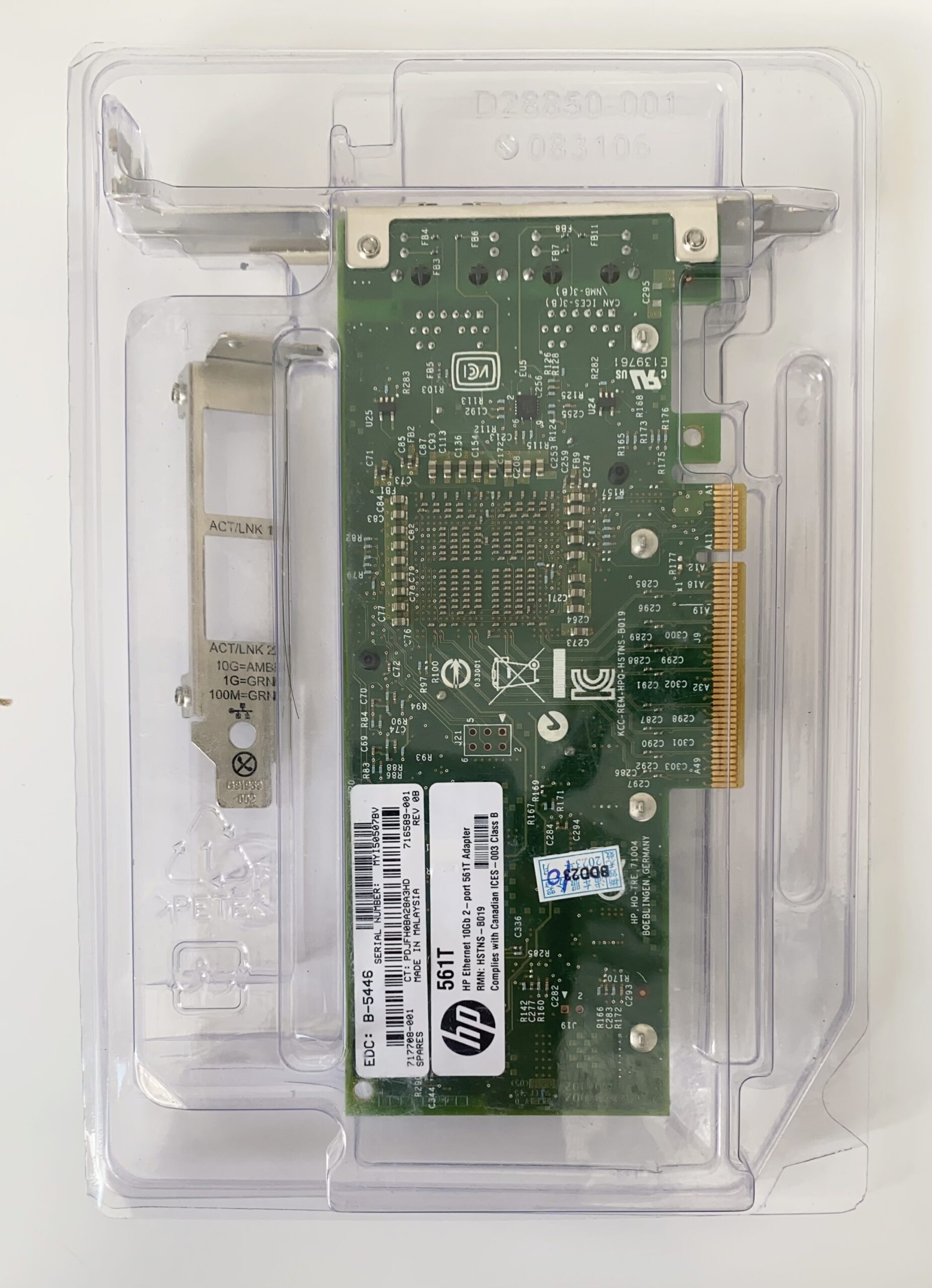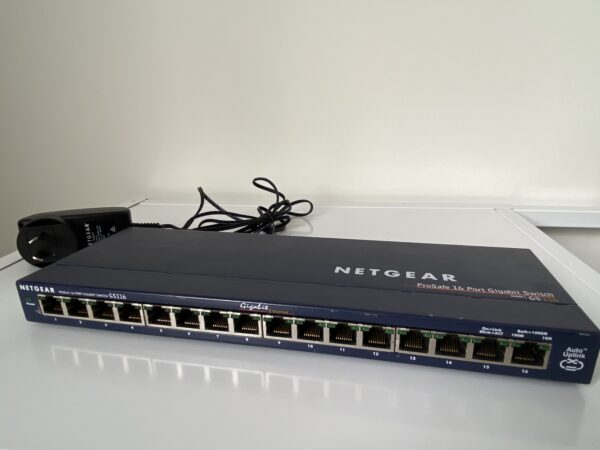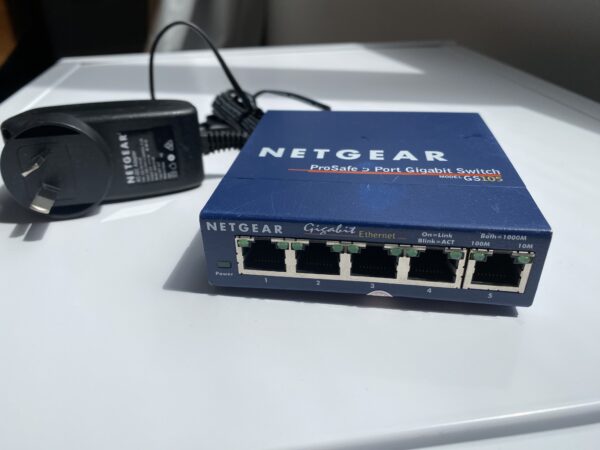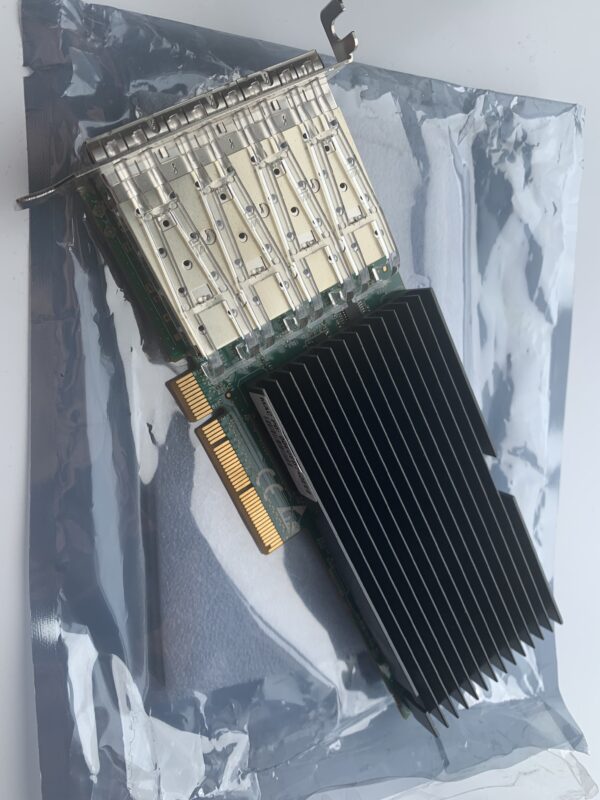Your cart is currently empty!
HPE Ethernet 10Gb 2-port 561T Dual-Port 10GBASE-T adapter
The HPE Ethernet 10Gb 2-port 561T adapter is a Dual-Port 10GBASE-T adapter, featuring the Intel X540 10 GbE solution in a PCIe 2.1 compliant form factor designed for HPE ProLiant Gen8 rack and tower servers. The HPE 561T adapter delivers full Line-Rate performance across all, utilizing CAT 6A UTP cabling (Or better) with distances up to 100 meters. Providing high performance Ethernet connectivity, it is ideal for virtual server and cloud computing environments.
2 in stock (can be backordered)
Description
Condition: refurbished
Used equipment.
Picture is the real thing.
But in very new condition.
Good working condition.
Free 2U half-height baffle.
Glance features
Operates at 100 Mb/s/1 Gb/s/10 Gb/s, Auto-Negotiation, on both ports
10GBASE-T connectivity supporting up to 100 meters with CAT 6A cabling (Or better)
Hardware acceleration TCP/IP/UDP stateless offloads superior small packet performance
Industry-Leading throughput and latency performance
Up to 40 Gb/s Bi-Directional near line rate throughput
Low profile design shipping with standard height and low-profile brackets
On chip temperature monitor (Sea of Sensors)
Support for Preboot eXecution Environment (PXE)
SR-IOV capable in hardware (Requires server FW, SW and OS support)
Active health system support
PXE, jumbo frames, checksum and segmentation offload, IPv6 and RSS
Field replaceable and upgradeable
IEEE 1588 (Time synchronization) ready
Support MACsec
Throughput-Theoretical bandwidth
This adapter delivers 20 Gb/s Bi-Directional Ethernet transfer rate per port (40 Gb/s per adapter), providing the network performance needed to improve response times and alleviate bottlenecks.
802.1Q VLANs
IEEE 802.1Q Virtual Local Area Network (VLAN) protocol allows each physical port of this adapter to beseparated into multiple virtual NICs for added network segmentation and enhanced security and performance.
VLANs increase security by isolating traffic between users. Limiting the broadcast traffic to within the sameVLAN domain also improves performance.
Checksum and segmentation offload
Normally the TCP Checksum is computed by the protocol stack. Segmentation Offload is technique for increasing outbound throughput of High-Bandwidth network connections by reducing CPU overhead.
The technique is also called TCP Segmentation Offload (TSO) when applied to TCP, or Generic Segmentation Offload (GSO).
Configuration utilities
This adapter ships with a suite of Operating System (OS)-Tailored configuration utilities that allow the user to enableinitial diagnostics and configure adapter teaming.
This includes a patented teaming GUI for Microsoft windows OS.
Additionally, support for scripted installations of teams in a Microsoft windows environment allow for unattended OS installations.
DPDK
This adapter supports DPDK with benefit for packet processing acceleration and use in NFV deployments
HPE Sea Of Sensors 3D
Support for the HPE Sea of Sensors which is a collection of 32 sensors that automatically track thermal activity -heat – across the server.
When temperatures get too high, sensors can initiate fans and make other adjustmentsto reduce energy usage
A significant improvement lies in the ability to apply fan speed increases only to the portion of the system that is rising in temperature, rather than all six fans in unison, which reduces the amountof energy used for cooling
IPv6
IPv6 uses 128-bit addressing allowing for more devices and users on the internet. IPv4 supported 32-bit addressing.
Jumbo frames
This adapter supports jumbo frames (Also known as extended frames), permitting up to a 9,500 byte (KB)transmission unit (MTU) when running Ethernet I/O traffic.
This is over six times the size of a standard 1500-byte Ethernet frame.
With jumbo frames, networks can achieve higher throughput performance and greater CPU utilization.
These attributes are particularly useful for database transfer and tape backup operations.
Network adapter teaming
This adapter support for NIC teaming helps IT administrators increase network fault tolerance and increased network bandwidth, the team of adapters can work together as a single virtual adapter, providing support for several different types of teaming enabling IT administrators to optimize availability, improve performanceand help reduce costs.
Optimized for virtualization
I/O Virtualization support for VMware NetQueue and Microsoft VMQ helps meet the performance demands of consolidated virtual workloads.
PXE
Support for PXE enables automatic deployment of computing resources remotely from anywhere. It allows anew or existing server to boot over the network and download software, including the OS, from a management/ deployment server at another location on the network.
Additionally, PXE enables decentralized software distribution and remote troubleshooting and repairs.
Receive Side Scaling (RSS)
RSS resolves the Single-Processor bottleneck by allowing the receive side network load from a network adapterto be shared across multiple processors.
RSS enables packet Receive-Processing to scale with the number ofavailable processors.
Server integration
This adapter is a validated, tested, and qualified solution that is optimized for HPE ProLiant servers.
Hewlett Packard Enterprise validates a wide variety of major OS drivers with the full suite of Web-Based enterprise management utilities including HPE Intelligent provisioning and HPE Systems insight manager (SIM) that simplify network management.
This approach provides a more robust and reliable networking solution than offerings from other vendors andprovides users with a single point of contact for both their servers and their network adapters.
TCP/UDP/IP
For overall improved system response, this adapter supports standard TCP/IP offloading techniques including:
TCP/IP, UDP Checksum Offload (TCO) moves the TCP and IP checksum offloading from the CPU to the network adapter.
Large Send Offload (LSO) or TSO allows the TCP segmentation to behandled by the adapter rather than the CPU.
Precision time protocol (IEEE 1588PTP)
Synchronization of system clocks throughout a network, achieving clock accuracy in the Sub-Micro second range, making it suitable for measurement and control systems.
VMware NewQueue and Microsoft Virtual Machine Queue (VMQ)
VMware NetQueue is technology that significantly improves performance of 10 GbE network adapters in virtualized environments.
Windows Hyper-V VMQ is a feature available on servers running windows server 2008 R2 with VMQ enabled Ethernet adapters
VMQ uses hardware packet filtering to deliver packet data from an external virtual machine network directly to virtual machines, which reduces the overhead of routing packets and copying them from the management OS to the virtual machine.
Additional information
| Weight | 0.5 kg |
|---|---|
| Dimensions | 22 × 14 × 4 cm |
| condition |






